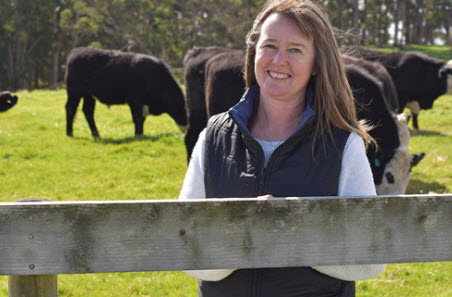Managing growth path key to Katrina’s MSA success
22 September 2017
With its lush green landscape and stunning views across Bass Strait, Wynyard on the North West coast of Tasmania is an idyllic spot - especially for raising some of the best beef in the State.
It’s where Katrina Simpson produces cattle that consistently achieve outstanding compliance rates to Meat Standards Australia (MSA) specifications which has led her to win Tasmania’s 2017 MSA Excellence in Eating Quality Most Outstanding Beef Producer award. (Click here for more details about the Tasmania MSA Awards)

“I used to breed my own cattle but now I buy in weaners, keep them for 12 to 18 months and sell at about 300kg dressed weight,” Katrina said
“I try to source grassfed Angus or Hereford steers from local producers and which have never had hormone growth promotants (HGPs) or antibiotics
“When I buy cattle, I pay close attention to their temperament and only source quiet, well-bred animals.
A MSA registered producer for the past 10 years, Katrina said the carcase feedback provided by the MSA system was one of its key advantages
“It’s great to get the feedback and also know that consumers are getting consistent, quality meat,” Katrina said
Katrina turns off around 30 head per year, with the cattle processed at Greenham’s abattoir at nearby Smithton, to supply Greenham’s well-known Cape Grim Beef brand
Minimal, low-stress stock handling is another management tool Katrina uses to ensure the cattle meet MSA specifications, in particular the requirement for pH to be below 5.71. Producers are encouraged to keep their cattle on a rising plane of nutrition especially for the month prior to being sent to the abattoir
“The only times they’re really in the cattle yards are when they first arrive at the property, and then when they’re ready to be sent for processing,” Katrina said
With its sandy loam soil types and 900mm average annual rainfall, Katrina’s property is a combination of low and high country which she under-stocks to enable her to manage the impacts of the high rainfall on her low country.
“The cattle are fattened on pastures year-round and then when grass quality starts to drop, they’re fed on silage and hay which I grow on the property as well,” Katrina said
“There is also some bush here which provides winter shelter and summer shade for the cattle
“They are pretty content I think.
The MSA Most Outstanding Beef Producer award was open to producers that used any production system to achieve MSA eligible cattle
For more information about the MSA system, visit: www.mla.com.au/ms
To look at your own carcase feedback and use the MSA Index calculator, visit: www.mymsa.com.au


